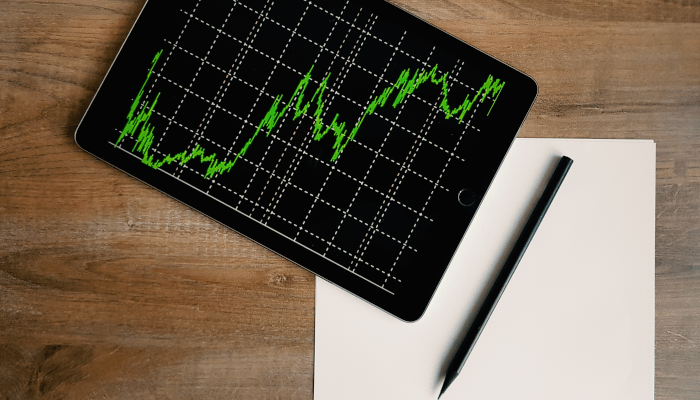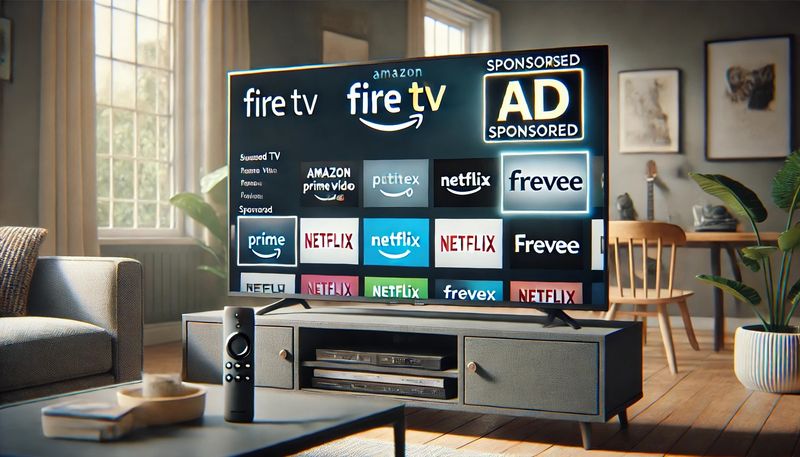Amazon offers you, as a seller and vendor, various possibilities to create and run PPC campaigns. But after the successful start of a PPC campaign, not everything is done. For your PPC campaign to be successful, it should be regularly monitored and optimized. In the following article, we will explain which key figures you need to know for campaign optimization, what optimization approaches are available and how optimization is carried out in practice.
- Amazon campaign strategy and key figures
- Requirements for PPC campaign optimization
- Optimization approaches at a glance
- Amazon PPC campaign optimization in practice
- Conclusion
You have not yet created and run a PPC campaign? No problem! Here you will find the respective articles for the corresponding ad formats with instructions and helpful tips:
- Create and structure sponsored products
- Create and structure sponsored brands
- Create and structure sponsored display
Amazon campaign strategy and key figures
At the beginning it is important to understand the various key performance indicators relevant to PPC campaigns that you will encounter in the course of campaign optimization. It depends on your campaign objective which key figures are particularly important for you:
- Do you want to increase brand awareness?
- Do you want to achieve more sales or higher profits?
- Or do you want to clear your warehouse?
If, for example, you want to make more profit, the ACoS is of great importance to you. You will find out how the other key figures can be assigned to your campaign strategy in the following.
Impressions of Amazon ads
An impression (also called "page impressions") is a measure of the success of online content. The term refers to how often an advertisement has been displayed to a user. It refers exclusively to the visual insertion of the advertisement.
Clicks on Amazon ads
Clicks, on the other hand, tell you how many users clicked on the ad after it was displayed.
Amazon Click Through Rate (CTR)
The click-through rate describes the ratio of "clicks on an ad" to impressions of the ad. Impressions or page views are defined at Amazon as the number of times the ad has been delivered. As a seller, your interest is that the CTR is as high as possible. However, if your CTR increases without increasing the number of sales, then your advertising costs will increase. In such cases, the Amazon Product Listing usually does not convince the buyer, which is why you should revise it in consideration of Amazon SEO aspects.
Cost-Per-Click (CPC)
Amazon PPC campaigns are billed according to the Cost-per-Click (CPC) or Pay-per-Click (PPC) principle. After that you pay for an ad per click. This means that you don't have to pay anything when you just display the ad. Only when a buyer clicks on the advertised item will you as the advertiser be asked to check out. The price per click is determined by the demand for a specific search term. If, for example, there are many sellers bidding on a certain search term (i.e. if demand is high), Amazon awards the first places to the highest bidders in an auction. The Amazon CPC then tends to go up. As a seller, however, you are interested in paying the lowest possible CPC, because this reduces your expenses. In general, the following rule applies: The more competitive the bid, the more likely the advertisement will be played.
ACoS
The ACoS (English: Advertising Cost Of Sales) is one of the most important key figures for your campaign. It shows how much money you have spent on advertising in relation to the turnover achieved with it. Example: You have a product that you sell gross for 20 €. Let's assume you spent 100 € on Sponsored Products ads within one week and achieved ten sales (sales independent of the ad, are not included in the calculation). This results in costs of 100 € and sales of 200 € (10 x 20 €). The ACoS is now 100 € / 200 € = 50 %. You could say: You have spent 50% of your gross income on advertising. Interpretation of the ACoS: Which values are good or bad? Is 50% now a lot or a little? That depends on your margin. If your margin after deduction of all costs and after taxes is also 50%, then with an ACoS value of 50% you make neither profit nor loss. The lower the ACoS value for the same absolute turnover, the more efficiently your campaign will run.
Note
Please note that Amazon always calculates the ACoS based on your gross sales. Strictly speaking, you have to deduct the value added tax from the sales. If we assume 19% sales tax, the correct ACoS in our example above would be (100 / (200 / 1.19) = 59.5%).
But is an ACoS value above your margin always bad? Not necessarily. Especially at the beginning, you will hardly be able to set up a campaign that is profitable in itself. Don't set this as your primary goal at the beginning either! In the beginning, the goal is to position your product in the search results in such a way that it will sell itself later on. So if you have to spend money for this, you should see these costs as a longer-term investment.
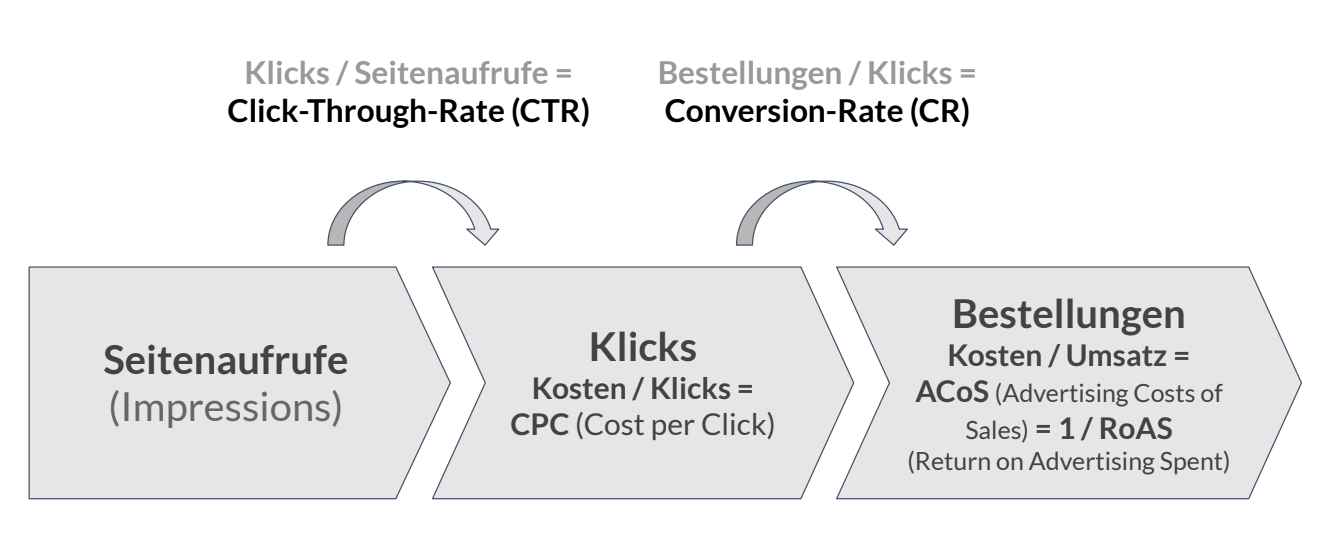
Relationships of the key figures
If you now look at all the key figures, you will see various connections:
- The higher your product margin is, the more you can spend per click on advertising (higher Amazon CPC)
- The higher your conversion (number of sales), the lower your ACoS or the more you can spend per click (Amazon CPC).
- The lower (higher) the price, the less (more) you can spend on advertising, as this reduces (increases) your margin.
- If your CTR increases without increasing the number of sales, then your advertising costs will increase. - However, in this case the listing does not (yet) seem to convince the buyer.
Let's look at the following example:
In a campaign, a bid was placed on the keyword "barbecue brush" with a maximum bid of 1 € per click. The advertiser wins the auction and the listing is played out. The customer sees the ad and clicks on you. At this moment the advertiser incurs costs of 0,81 €, because the second highest bid was 0,80 €. After three days the customer buys the clicked on product of the advertiser for 19,99 € and also buys twice the same cleaning agent for 5,99 € each from the same dealer. If this were the only action of this campaign, this transaction would be shown in the advertiser's statistics as follows:
| Number of impressions | 100 |
| Number of clicks | 4 |
| Cost of the click | 0,80 € |
| Click-Through-Rate | 4% (Number of clicks / number of impressions) |
| Conversion Rate | 25% (Number of conversions / number of clicks) |
| Number of conversions 1 day/ 7 days/ 30 days | 0 / 3 / 3 |
| Number of conversions 1 day/ 7 days/ 30 days (advertised SKU) | 0 / 1 / 1 |
| Sales 1 day/ 7 days/ 30 days | 0 / 31,97 € / 31,97 € |
| Sales 1 day/ 7 days/ 30 days (advertised SKU) | 0 / 19,99 € / 19,99 € |
| ACoS (advertising costs in relation to sales) | 10% (3,20 € / 31,97 €) |
Requirements for PPC campaign optimization
Before you start optimizing your Amazon PPC campaigns, make sure you meet the following requirements to make optimization easier. If you notice that you have not implemented some points in your campaigns, adjust them in the first step.
- Product data of the products to be advertised are optimized
- Keyword and competitor research as a basis for each campaign
- Differentiated campaign structure
- Sufficient data: wait two weeks after the campaigns have started
Optimization approaches at a glance
When optimizing PPC campaigns, the main goal is to sort out or rework poorly performing keywords and ASINS and to give good performing search terms more reach. Imagine the different campaign types like a pyramid.
- At the bottom of the pyramid is the automatic campaign, which covers the largest playable area.
- On the next level follows the broad manual campaign, which already covers more precise keywords.
- At the top is the exact manual campaign, which covers only a handful of relevant keywords. These keywords are insights that you can gain from the lower two levels.
The exact campaign is the most important one because it contains keywords that have a very high probability of purchase. The basic principle of optimization is therefore to filter out relevant keywords from the broad campaigns and, over time, to include more and more keywords in the exact campaign.
The individual optimization steps are explained below:
Transfer of Amazon keywords from the automated/broad campaign to the manual/exact campaign
A common approach is to use both automatic/widespread and manual/exact campaigns. Use the automatic/width campaigns to get additional ideas for keywords or products. Profitable keywords are transferred successively to your manual/exact campaigns, because there you can control the bidding exactly. Afterwards, the keyword should be excluded from the automatic campaign so that the two campaigns do not bid on each other.
Increase and decrease bids for keywords
It is also very important that you always track and optimize your bids on individual keywords. The optimal bid differs depending on the keyword. For this reason, the bid for each keyword can be controlled separately in manual campaigns. But always wait at least one week between the adjustment of the bid prices. Otherwise you will not be able to make a statement about the adjusted bid, as no development could be considered yet.
Rules for CPC bid optimization:
- If the cost of sale for a keyword is above the target value, lower the bid to test whether advertising expenditure and sales can be brought into a desirable relationship.
- If the cost of sale is below the target, test whether the reach of the ad - and the associated sales - can be increased by raising the bid price.
- If keywords do not generate sales or do not generate enough impressions, test whether a higher bid will help.
- Stop keywords that only generate costs and no conversion over a longer period of time or that cannot be adjusted into a profitable bid price range. You can better use your budget elsewhere.
Addition of keywords to be excluded
In Amazon PPC campaign optimization, another important component is the addition of keywords to be excluded. Eliminate unwanted search queries using negative keywords to reduce costs. Your ad will then no longer be displayed for user queries with these exclusionary keywords. For example, if you advertise a golden picture frame but find that your ad is also displayed under picture frame black, you should add this keyword to the list of negative keywords. A customer looking for a black picture frame will most likely not want to buy a golden one.
When excluding Amazon keywords, you have two different match types to choose from:
- Exact negative: Your ad will only be excluded if the search query exactly matches the excluding keyword you entered or has a slight difference (e.g. singular / plural).
- Excluding phrases: ads are excluded if the search query contains the excluding keyword as part of the phrase or as a whole.
Adjust the match type of existing Amazon keywords
Often you have chosen the match type "Largely" for several of your search terms at the beginning. On the one hand, this way you discover search terms you had not thought of before. However, on the other hand, you will also get fade-ins for search terms for which you do not want to be found. In the long run you should therefore not leave the search terms in "Mostly", but transfer them to the match type "Group of words" or "Exactly matching". "Extensively" only serves at the beginning to collect more ideas for keywords which you can use for your advertisement.
Optimize ad groups
In the context of PPC campaigns you have the possibility to create ad groups. Within an ad group there are many different products that use the same keywords. Over time, however, you as a seller will realize which products sell best within an ad group. To achieve the maximum number of sales with this ad group, products with poor performance can be slowly removed from the ad group. In this way, you send impressions and clicks to products that more effectively convert clicks into purchases.
Amazon PPC campaign optimization in practice
Now that you have gained an overview of the possible optimization approaches, it is time to apply what you have learned in practice. But what data does Amazon provide you with and where, and how can you read from it what needs to be optimized?
Advertising Console
All data on your campaigns can be found in the Amazon campaign overview or on the so-called Amazon Advertising Console.

Impressions, clicks, CTR, issues, orders, sales and ACOS are displayed directly as key figures for each campaign. First look at how many sales were generated by the campaigns (column Orders) and what you paid for them (column Expenditures). From this you can draw the first conclusions directly.
- case: No orders: In this case you should check if you have chosen the right search terms and if the bid per term was high enough. For terms that are rarely searched for, even high bids will not help. Also check whether the daily or campaign budget is sufficient for the respective campaign and increase it if necessary. It is also possible that the campaign is displayed but customers do not click on it. In this case, a too low conversion rate could be the problem (e.g. if there are no or bad ratings for the product).
- case: High sales/high cost of sales: Here you buy the sales for too much money. To get to the bottom of this, you have to analyze on keyword level where the cause lies.
- case: High sales/low cost of sales: This is the desired scenario of every advertiser. Check whether you can further increase the daily or campaign budget for the respective campaign. Because for every euro you put in here, you get more sales.

You can also adjust your budget and end date directly from the advertising console. You also have the ability to stop or archive campaigns with one click. You can also move campaigns to a portfolio or create a new one. Often, however, this brief overview is not enough and you as an advertiser have to dig even deeper to get better insights. For many campaigns, it can also be too confusing to read data from the view. Amazon offers you the possibility to create and download various reports for this purpose. Navigate to the tab Advertising reports and click on Create report. Afterwards you can choose which report you want to create.
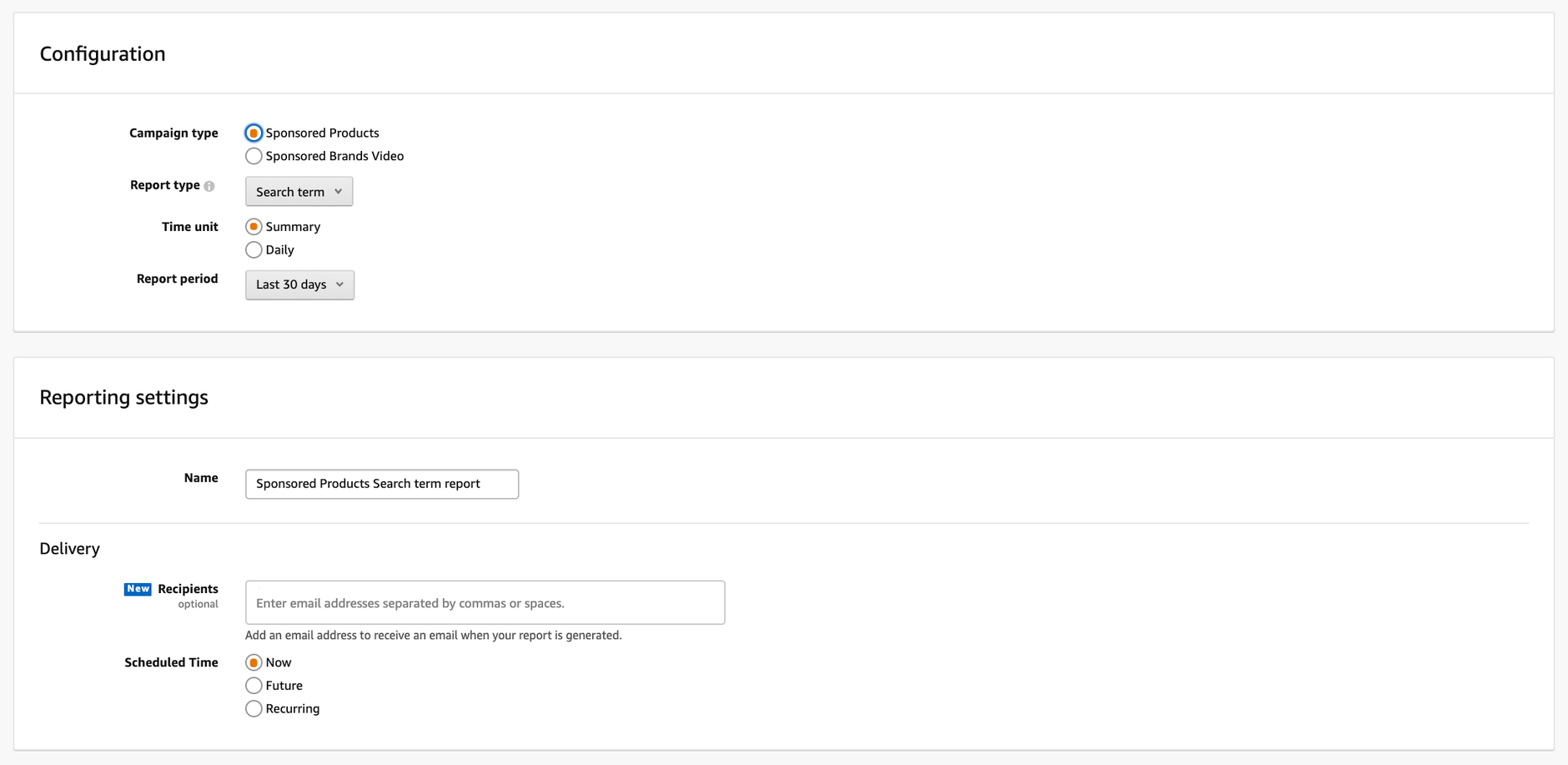
Different report types are available.
For Sponsored Products you can download the following reports:
- Search term report: gives an insight into the search terms entered by customers when searching on Amazon that led to at least one click. With the help of this report you can identify powerful search queries and find negative keywords for keywords under which you do not want to be displayed (can be generated for the last 60 days). The report includes the following columns: Start and end date, currency, campaign name, ad group name, keyword, client search term, match type, visuals, clicks, CTR, CPC, spend, 7-day sales, ACoS, ROAS, 7-day orders, units, CR, other SKU units, advertised SKU sales, other SKU sales
- Targeting Report: provides insight into sales and performance statistics on targetings in all campaigns that have achieved at least one impression. In this report you can see the performance of your targeting over time and adjust your targeting based on this data (can be generated for the last 90 days).
- Purchased Products Report: contains information on the unadvertised ASINs that customers purchased after clicking on your ad. This report can help to explore new advertising opportunities and can provide insight into buying habits (can be created for the last 60 days.)
- Placement report: presents campaign results at top search results compared to all other placements. The report lets you view results across different placement types and identify SP campaigns that could benefit from bidding adjustments by placement (can be generated for the last 90 days.)
- Promoted Products Report: provides insight into sales and performance statistics for promoted ASINs in all campaigns that have achieved at least one impression. You can use this report to view the performance of your ads over time and determine if you need to change your advertising strategy.
- Campaign Report: gives you a better insight into the overall results of your campaign (can be generated for the last 18 months.)
- Performance over time report:** shows clicks, cost per click and spend for all your Sponsored Products Campaigns. It helps you to track total spend and results (can be generated for the last 90 days.)
For Sponsored Brands you have the following report options:
- Keyword Report: provides insight into sales and performance statistics on keywords in all campaigns that have achieved at least one impression. With this report you can see the performance of your keywords over time and based on this you can better adjust your bid (can be generated for the last 90 days).
- Keyword Placement Report: gives you an overview of your keyword performance for different placement types (can be generated for the last 90 days.)
- Campaign report: gives you a better insight into the overall results of your campaign (can be created for the last 60 days.)
- Campaign Placement Report: gives you a summary of your campaign results for different placement types.
Evaluation of individual reports in Excel
Amazon offers you the possibility to make extensive updates via an Excel spreadsheet. In a first step, please download the Excel file (Bulk Table) (see Image 5 - Step 1).
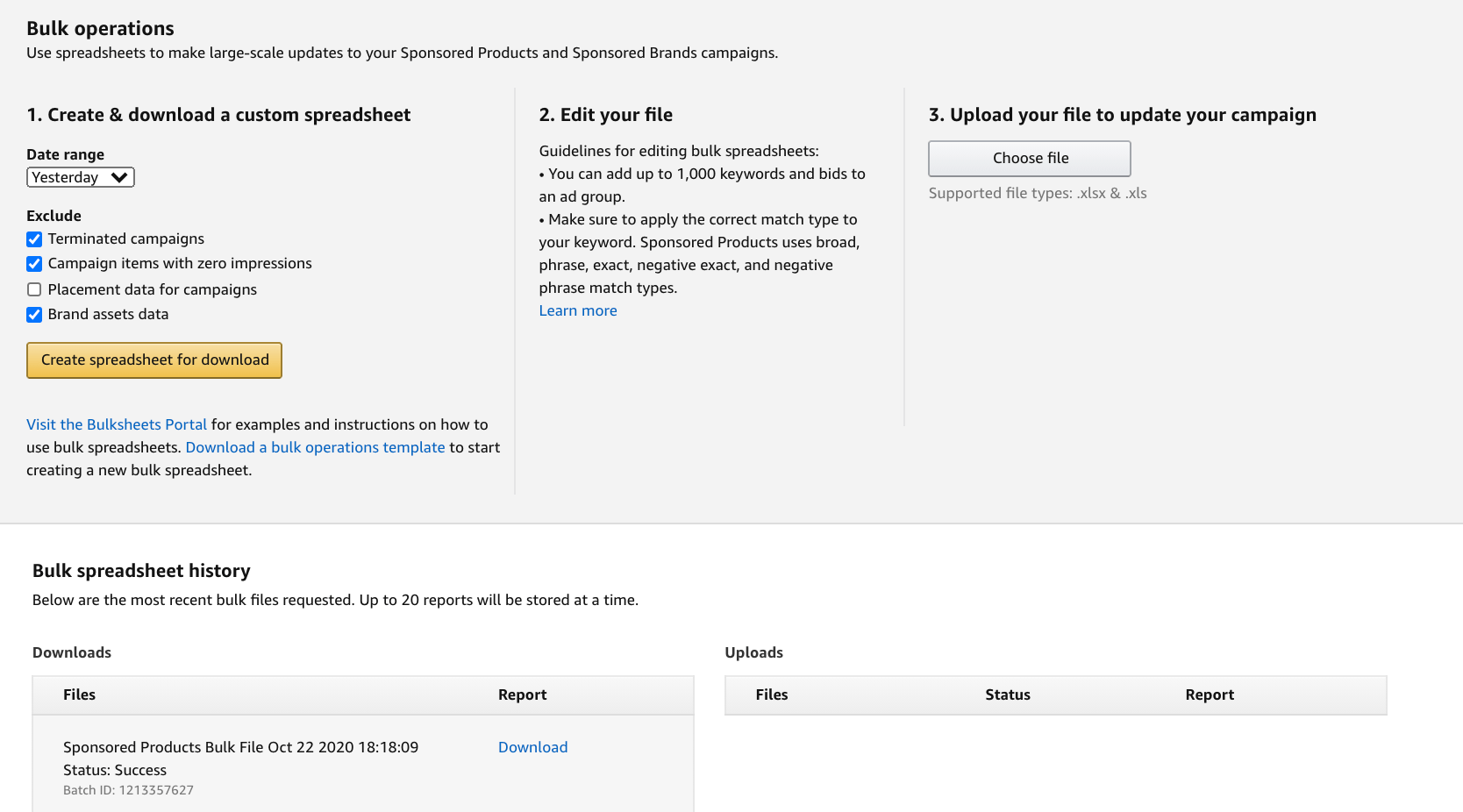
You can then edit them or evaluate data. This offers you, among other things, the possibility to filter your Excel spreadsheet by considering various aspects. For example, find out which search terms generate the least number of orders by having Excel filter the Orders column.
If you have made settings to the table, you can upload the modified table under point 3 (see Image 5). Your campaign will then be updated. This will allow you to update your campaigns more quickly instead of clicking through each campaign.
Amazon Advertising API
You also have the possibility to manage your campaigns programmatically with the Advertising API provided by Amazon. In order to use the Amazon API, you must apply for participation on the following website: https://advertising.amazon.com/en-gb/about-api?ref_=a20m_us_hnav_lng_en_gb
Note, however, that some development skills are required to use the API.
Note for vendors: Amazon Vendor API
Amazon provides a modern REST interface especially for vendors. Which possibilities you have as a vendor with it and how you get access to it, we explain in our article on Amazon Vendor API.
Monitoring your campaigns with AMALYTIX
But our Amazon Monitoring Tool AMALYTIX can also help you monitor your campaigns. With our tool, you no longer need to download reports from Seller Central and then evaluate them in Excel. AMALYTIX pulls the data automatically via the Amazon Advertising API. You even have the option to create your own filters. For example, you can create a filter that shows you all the keywords that you have used to generate the fewest orders. Save this filter under a name so that you can call it up again later with just one click.

Once you have determined the unprofitable search terms, you can then place them directly on the negative list in the respective campaign. Simply select the search term and then click on the button Add search terms to negative keywords.
Free trial
Just register for a 14-day free trial and we will show you how our Amazon Seller Tool and Amazon Vendor Tool can help you monitor your marketing activities on a daily basis. Start your free trial now
Conclusion
Every Amazon seller using AMZ PPC should also invest the appropriate know-how in optimizing their campaigns. If you do not optimize your campaigns, you may waste money that could have been better invested otherwise. Take your chance to gain insights! The correct control of all search terms is what makes a successful PPC campaign at Amazon. Since Amazon unfortunately provides only limited historical data, you should definitely pay attention to regular reporting. This work can be done by a suitable Amazon tool, which always downloads the data for you - like AMALYTIX.
